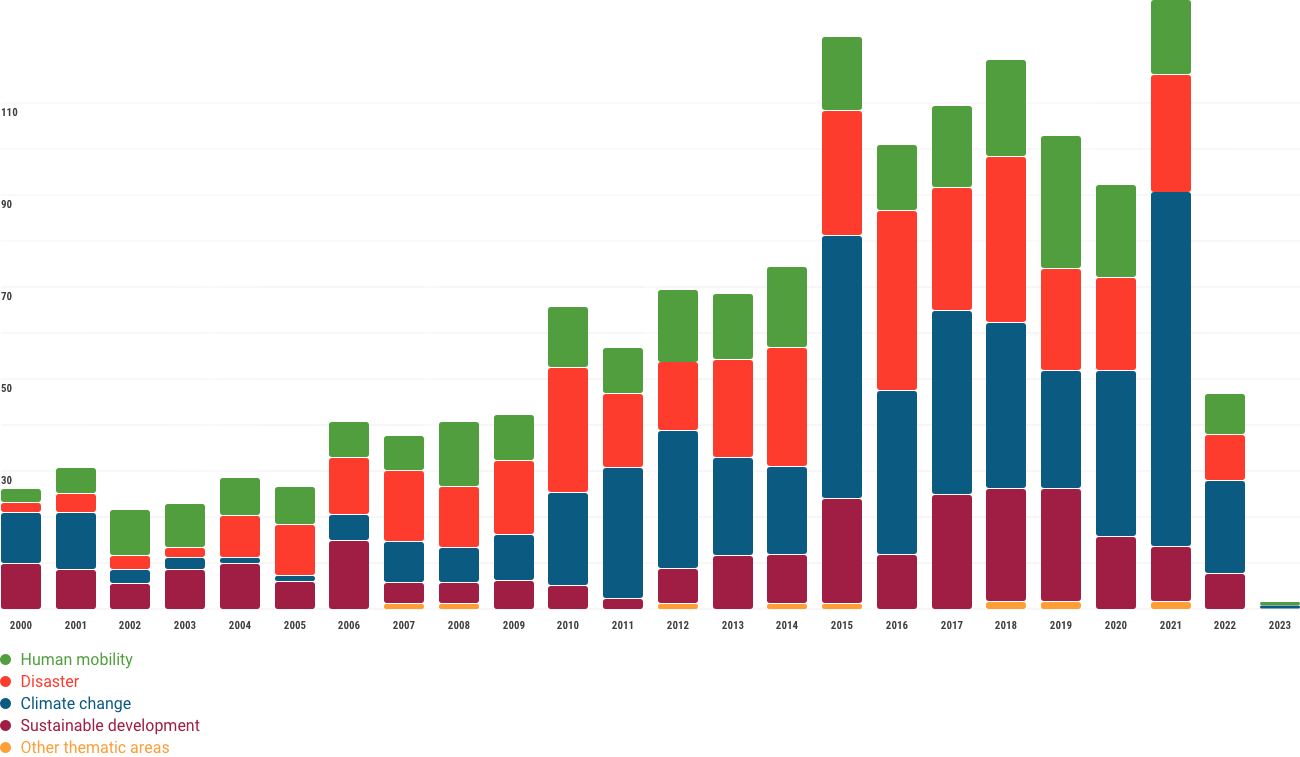This online database compiles over 1618 policy instruments - including 1388 national policy instruments in 172 countries and 230 bilateral and/or regional policy instruments. Each of these instruments contains provisions of relevance to human mobility in the context of disasters, the adverse effects of climate change, and environmental degradation.
This interactive dashboard provides an overview of the 1618 policies published between the 1940s and 2023 included in the database, which you can explore by country, region and theme. More advanced search options are available in the policy database at the link below the dashboard.
*Only countries with policies in the CLIMB database are included in the drop-down list.
Disclaimer: The boundaries and names shown and the designations used on this map do not imply official endorsement or acceptance by the United Nations or the International Organization for Migration. Final boundary between the Republic of Sudan and the Republic of South Sudan has not yet been determined. Dotted line represents approximately the Line of Control in Jammu and Kashmir agreed upon by India and Pakistan. The final status of Jammu and Kashmir has not yet been agreed upon by the parties. A dispute exists between the Governments of Argentina and the United Kingdom of Great Britain and Northern Ireland concerning sovereignty over the Falkland Islands (Malvinas).
The platform contains 1618 instruments identified in 172 countries and territories across the five geographic regions established by the UN: Africa, Americas, Asia, Europe, Oceania.
The platform contains 1618 national, regional and sub-regional instruments identified in 172 countries and territories across the five geographic regions established by the UN. 52 of the identified countries are in Africa (30.5%), 39 in the Americas (22.5%), 34 in Asia (20%), 31 in Europe (18%) and 16 in Oceania (9%). In terms of national instruments, the database contains:
- Africa: 482 national instruments across 53 countries;
- Americas: 394 national instruments across 39 countries;
- Asia: 254 national instruments in 33 countries;
- Oceania: 167 national instruments across 16 countries;
- Europe: 91 national instruments across 31 countries.
Distribution of instruments by policy sector
- Instruments were categorized according to their thematic policy area.
- 22.75% of the identified instruments (359) are related to human mobility governance, including immigration, foreigners’ status, asylum and refugee laws, border management, and internal displacement.
- 26.75% of the instruments recorded in this platform (422) are related to disaster management, including disaster risk reduction, disaster risk management, disaster response, and civil protection.
- Another 552 (34.2%) instruments are related to climate change governance, of which over 333 correspond to documents and submissions encouraged or required under the UNFCCC, such as national adaptation plans, nationally determined contributions or national communications.
- Around 274 (17.5%) instruments have been categorized under the sustainable development thematic category, which includes diverse instruments related to economic development, rural and urban development, poverty reduction, land and ecosystem management (including national action programmes to combat desertification), environmental management, health, and housing.
Regional priorities set the tone for policy development.
Africa and Arab States
Pastoralism, drought, sustainable land management, development and youth, internal displacement in conflict and disaster settings, and free movement.
Asia and the Pacific
Overseas employment, (seasonal) labour migration and remittances, protection of migrants in crisis situations abroad, planned relocation, and climate-resilient development.
Europe and North America
Civil protection, temporary protection, and border management.
Latin America and the Caribbean
Temporary protection, disaster preparedness, and response, regional cooperation.
- Existence of instruments and provisions in relation to GCM actions and objectives in 50 selected countries

Newsletter
Subscribe to our newsletter.


